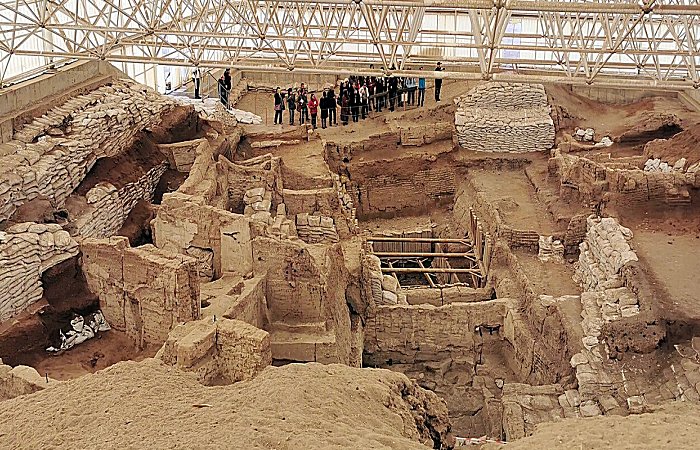Conny Waters – AncientPages.com – The Neolithic city of Çatalhöyük in central Anatolia, Turkey is a significant archaeological site. Located in the Cumra district of Konya, the ancient city was inhabited from approximately 7100 to 5950 BC, with a population of 3,500 to 8,000 at its peak.
Female-centered practices and changing kinship patterns over time in Çatalhöyük.
Shown are two Çatalhöyük figurines (credit: Mellaart International and the British Institute at Ankara). Centre: reconstruction of a typical Çatalhöyük building (credit: Kathryn Killackey). Left: Building 6 with six genetically studied burials (blue on building map) and their genetic connections (lines), and their inferred pedigree. Centre: Grave good frequencies and a stylized female infant burial with beads shown in purple. Lower right: The frequency of genetic relatives within 15 buildings, spanning about 500 years (bottom right). Credits: (Bottom Left) Mellaart International; (Top Center) K. Killackey; (Top Right) The British Institute At Ankara.
A team of international researchers has conducted a comprehensive investigation into the genetic material of 131 individuals buried within 35 houses at Çatalhöyük.
Their primary goal was to determine the genetic relationships among individuals buried together within the same buildings.
What were the conditions of life approximately 8,000 to 9,000 years ago for the inhabitants of the East Mound at Çatalhöyük, a significant Neolithic settlement in central Anatolia? Yet another important subject for the researchers was what roles did women occupy within their society? Was the Neolithic settlement at Çatalhöyük a matriarchate?
The research revealed a noteworthy aspect which is the preference given to female lineages, and individuals from the same houses or nearby ones were primarily related through the maternal lineage. Apparently, this lineage played a key role in connecting Çatalhöyük household members.
Çatalhöyük after the first excavations. Image credit: Omar hoftun – CC BY-SA 3.0
The question of whether the people of Çatalhöyük lived in a society dominated by women has been a topic of interest for many years.
The idea of a prehistoric matriarchate is not new; it has its roots in ancient times and continues to be explored. Archaeologists have engaged in ongoing debates about the social structure of this settlement, with British archaeologist James Mellaart, who was first to discover Çatalhöyük in 1958. Mellaart was also the first, who proposed the possibility of a matriarchal society there in the 1960s.
This hypothesis has long remained an intriguing aspect of archaeological research into Çatalhöyük’s history.
A very large Neolithic and Chalcolithic proto-city settlement in southern Anatolia, 7400 BC. Population 5,000 – 7,000. Large numbers of buildings clustered together. The inhabitants lived in mudbrick houses. No footpaths or streets between the dwellings. Most were accessed by holes in the ceiling and doors on the side of the houses, with doors reached by ladders and stairs. Image credit: Murat Özsoy 1958 – CC BY-SA 4.0
The recent study confirms that that being biologically related was just one factor among many when it came to forming households at Çatalhöyük.
Other results reveal that female offspring of the settlement maintained connections to buildings 70 to 100% of the time, whereas adult male offspring likely relocated. The team also found a notable inequality in burial practices, showing that female infants and children are given preferential treatment.
Specifically, they receive five times more grave goods compared to their male counterparts.
This study further demonstrates how social organization patterns evolved over time at Çatalhöyük. In the early stages of the settlement, it was customary for individuals buried together within residential structures to belong to extended family units. In later periods, researchers discovered groups of newborn children, who were genetically unrelated yet buried within the same household. Meanwhile, their mothers shared similar dietary patterns.
This finding suggests that genetic relationship gradually became less important in social organization. Such a shift could be attributed to the increasing prevalence of fostering and adoption-like practices within these communities.
Written by Conny Waters – AncientPages.com Staff Writer




